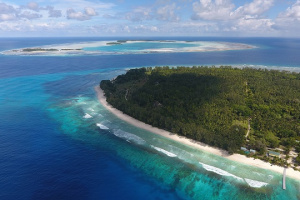Seychelles Marine Spatial Plan eyes creation of new independent ocean authority
General |Author: Sharon Ernesta | October 30, 2020, Friday @ 10:54| 9220 views
The 30 percent or 410,000 squares kilometres of the island nation's 1.3 million squares kilometres EEZ will now be fully safeguarded to encourage sustainable development. (Michael Scholl)
An independent ocean authority is expected to be set up in Seychelles by 2025 to ensure proper monitoring and protection of the Seychelles Exclusive Economic Zone (EEZ). The proposed authority is being considered now that the island nation has reached its target of 30 percent ocean protection around some of its outer islands as part of the Seychelles Marine Spatial Plan (SMSP).
“Research for the concept of an independent ocean authority is under way including financial requirements and capacity needs. This was the preferred option that was determined through multiple stakeholder consultations. A framework and costing for the authority were developed and are being evaluated by the government,” Helena Sims told SNA last week.
Sims, who is the Project Manager for the Seychelles Marine Spatial Plan, explained that the important milestone was gazetted in March this year where 13 new areas are now under protection.
According to Sims “designating 30 percent of its marine area by 2020 means Seychelles has tripled the UN Convention of Biological Diversity target for 10 percent by 2020 in marine protected areas, and the UN Sustainable Development Goal SDG-14 for 10 percent coastal and marine protection."
The 30 percent or 410,000 squares kilometres of the island nation's 1.3 million squares kilometres EEZ will now be fully safeguarded to encourage sustainable development and to adapt to the effects of climate change. The protected areas are split into two ‘zones’. There are High Biodiversity Protection Areas (Zone 1) where almost no extractive human activities are allowed. These Zone 1 areas include one of the world’s most ecologically important habitats, the waters around the Aldabra Group – a UNESCO world heritage site.
 |
| These Zone 1 areas include one of the world’s most ecologically important habitats, the waters around the Aldabra Group – a UNESCO world heritage site. (Seychelles Islands Foundation) (SBC YouTube) Photo License: All Rights Reserved |
The area is also home to the Indian Ocean’s only dugongs, the world’s second-largest raised atoll, regionally significant populations of seabirds, and critically-endangered turtles. It is on migratory routes for calving Southern Ocean humpback whales and includes the highest fish densities in Seychelles.
“There are also Medium Biodiversity Protection and Sustainable Use Areas (Zone 2), designed to conserve natural ecosystems while allowing some economic activities, including fishing, tourism charters, renewable energy, and others. Significant new conditions will regulate businesses operating in these areas,” explained Sims.
The newly designated protection areas deliver on a ‘debt-for-conservation’ deal that Seychelles – 115 islands in the western Indian Ocean - signed with The Nature Conservancy in February 2016, the first such deal for marine conservation in the world.
The Marine Protection Areas are a key part of the new Seychelles Marine Spatial Plan that covers the second-largest area of ocean in the world (after one in Norway) and is the largest plan for tropical waters to account for both conservation and climate change.
Beyond the Marine Protection Areas, the Marine Spatial Plan as a whole also covers how Seychelles’ remaining 70 percent of ocean is addressed in terms of increasing management of all marine resources, regulatory attention, and unified government oversight of all activities that take place to support the country’s Blue Economy.
Sims explained that now the project will enter into an implementation phase which has been delayed by six months because of the COVID-19 pandemic.
“Designing implementation is essential to ensure that the SMSP can be successfully implemented and effectively managed. Implementation of the SMSP involves several components including: financing, monitoring, enforcement, governance, and adaptation or revision of the plan over time,” added Sims.
The Project Manager the implementation phase to start in 2021 will involve all partners in the marine sector for coordination, monitoring, enforcement and compliance. The process will include a wide range of activities such as review of regulations, management plans, frameworks, capacity building as well as costing and financing.
Other key outcomes of the MSP by 2025 include a comprehensive, multi-sector marine spatial plan implemented from 2021, long-term monitoring of indicators for climate change threats and a decision-making framework for all future sustainable economic development is actively used.
Back
